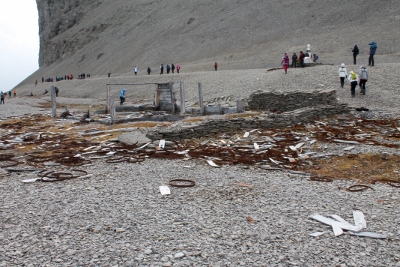Beechey Island Sites National Historic Site of Canada
Beechey Island, Nunavut

General view
© Parks Canada Agency | Agence Parcs Canada, A. Fitzsimmons, 2015.
Address :
Beechey Island, Nunavut
Recognition Statute:
Historic Sites and Monuments Act (R.S.C., 1985, c. H-4)
Designation Date:
1993-11-20
Dates:
-
1845 to 1846
(Significant)
-
1852 to 1854
(Significant)
Event, Person, Organization:
-
Sir John Franklin
(Person)
Other Name(s):
-
Beechey Island Sites
(Designation Name)
-
Franklin Wintering Camp, Northumberland House, wreck of Breadalbane, Devon Island site
(Name of contributing resources)
Research Report Number:
1993-050, 2006-CED-SDC-033
Description of Historic Place
Beechey Island Sites National Historic Site of Canada is located primarily on Beechey Island, a peninsula connected to Devon Island, in the Arctic Archipelago of Nunavut. It is a bare, windswept island, which rises to a small hill, fringed by a narrow beach. This setting provided suitable flat and sheltered land for Arctic expeditions. The site is comprised of five archaeological sites on Beechey Island, and Devon Island and in the nearby sea, namely the Franklin wintering camp of 1845-46, Northumberland House, the Devon Island archaeological site at Cape Riley, two message cairns and Wreck of Breadalbane National Historic Site of Canada. Official recognition refers to six polygons encompassing the principal archaeological zones both on land and in nearby shallow waters in their existing spatial relationships.
Heritage Value
Beechey Island Sites was designated a national historic site of Canada in 1993. It is designated because:
— it comprises the 1845-46 wintering site of Sir John Franklin's ill-fated Northwest Passage Expedition as well as an archaeological complex containing representatives of most types of 19th-century Arctic exploration sites;
— the Island is also an important shrine for visitors because of its association with the "grand rendezvous" for the Franklin search expeditions of 1852-54, which resulted in the exploration and mapping of a large part of the Canadian Arctic Archipelago, and with the "myth of Franklin".
Beechey Island Sites is associated with the exploration of Canada’s High Arctic. Over the years, many different ship crews wintered here, beginning with Sir John Franklin’s team in 1845-46. The party wintered on Beechey Island during its search for a Northwest Passage, but became icebound off King William Island the next year. All eventually perished, leaving scanty records of the exploration. As a result of their disappearance, Franklin’s expedition became the cause of a massive survey and exploration of a large portion of the Canadian Arctic. Beechey Island was used as a base and supply depot for these expeditions for the next decade. The search led to further significant discoveries, including the discovery of three Northwest Passages and the mapping of half of the Canadian Arctic. This flurry of activity left a large number of archaeological resources on the island and in the waters adjacent, ranging from cairns and graves to the ruins of wooden buildings and the wreck of Breadalbane.
Source: Historic Sites and Monuments Board, Minutes, November 1993, July 2007.
Character-Defining Elements
Key elements contributing to the heritage value of this site include:
— its location on Beechey Island, Devon Island and the nearby sea in the Arctic Archipelago of Nunavut;
— its setting on a bare, windswept landscape, which rises to a small hill, fringed by a narrow beach, providing suitable flat and sheltered land for Arctic expeditions;
— any archaeological resources related to the Franklin wintering camp, including any remaining structural material or artifacts from the washing, drying, and forge areas, the carpenter’s shop, the storehouse and the garden area, as well as any grave mounds, memorials, cairns, and depressions;
— any archaeological resources related to Northumberland House, including any remaining structural materials, tent rings, cairns, memorials, and artifacts;
— any archaeological resources related to Wreck of Breadalbane National Historic Site of Canada, including the underwater remains of the ship, the hull, fragments of the vessel and the surrounding debris field;
— any archaeological resources related to the Devon Island site at Cape Riley, including pre-contact tent-rings and structures, structural features from the Franklin occupation and the Franklin search expeditions, cairns and artifacts, including those from the cargo of Breadalbane;
— the two cairns located at the top of Beechey Island;
— evidence of pre-contact Aboriginal and Inuit occupation, including tent rings, structural material, and artifacts;
— the integrity of any surviving or as yet unidentified archaeological remains which may be found within the site in their original placement and extent, including any above ground or below ground or underwater archaeological remains related to the occupation by Sir John Franklin’s expedition, and by subsequent expeditions;
— viewscapes to and from each site and across Erebus and Union Bays.